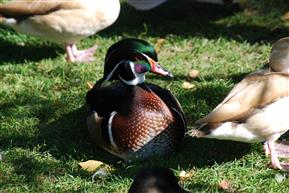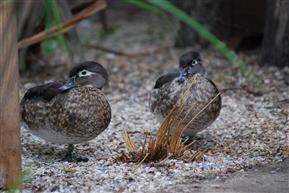Carolina or North American Wood Duck
Aix sponsa - Normal, Blond, Silver, Dark Silver, Platinum, American Silver, Blue Pastel
The Carolina or American Wood Duck is native to North America and nests in hollow trees and particularly favours old woodpecker sites. It is the availability of suitable nest sites that determines ultimate numbers in the wild but the Carolina has readily adapted to using artificial nest boxes and their numbers have significantly increased following the provision of artificial sites.
Wood Duck nest boxes
There are some very good designs for Carolina nest boxes and if you enter Wood Duck nest boxes into your search engine you will be surprised at how many different designs and detailed construction guides you will find. Having been maintained in captivity over many generations Carolinas will readily accept almost any design of nest box that can be at ground level but they still show a distict preference for boxes that are raised off the ground.
Unless the Carolinas are maintained full winged in an aviary it is necessary to provide a ramp to the entrance hole. In late winter and early spring both the male and female will be observed investigating the various boxes and this is quite amusing because at first site it seems strange to see a duck or pair of ducks quite happily walking up a ramp and standing outside or a nest box that can be several feet above ground level.
The Carolina is another species that is ideal for the beginner in waterfowl, it is exotic, hardy, easy to maintain on standard pellets and wheat and can be long lived. It will readily adapt to life in an aviary with a small pond provided clean water is available. If kept in an aviary where there is not access to a large pond the emphasis should be on quality of water rather than quantity. Water can be provided in a small greenhouse gravel tray or similar that is easy to replenish on a regular basis so that the water is always clean and fresh. While this option may not be as aesthetically pleasing as a small artificial pond it is far easier to clean and consequently cleaning regularly is less of a chore. Particularly in the summer water quite rapidly goes off in a small concrete pond or similar. Waterfowl have a strong desire to swim and bath and consequently will do so even if the water is stale and dirty and this is a sure way of ending up with a condition known as wet feather. While wet feather is not usually fatal it is distressing for the bird and the owner to see what was a stunning bird in pristine condition denigrated to something resembling a wet rag.
Wood Duck Breeding
Carolinas almost always breed at one year old and are regularly one of the first species to lay, the first egg can be expected any time from late February to the middle of March, depending on weather conditions. A clutch usually consists of between nine and fourteen eggs and if the eggs are taken for artificial hatching a Carolina will readily produce a further two and sometimes three clutches. The number of eggs in each repeat clutch will usually be one or two eggs less than in the preceding clutch. Incubation takes 30 days, the ducklings are a little smaller than the Mandarin and perhaps slightly more difficult to rear. This said they are still relatively easy to get feeding on standard waterfowl or poultry crumbs and can easily be encouraged to feed if some crumbs are sprinkled over the ducklings. They find picking the crumbs that become lodged in one another’s down irresistible and once they have taken a small quantity of crumbs in this way they will quickly take to eating the crumbs provided in a shallow bowl. The ducklings have evolved to hatch in hollow trees and consequently they frequently have to climb up the inside of the tree to get out. This is something that needs to be remembered when artificially rearing Carolinas, if the brooder sides are made off wood then you will need to put a lid on the brooder because in the first two or three days of life Carolinas are very adept at climbing out. Once away from he confines and warmth of the brooder the ducklings will quickly perish so care should be taken to avoid this disappointment.
Wood duck Mutations
As with the Mandarin there are a number of colour variations or mutations and some of these are quite stunning. Some colour forms are still vary rare and consequently expensive in Europe but as with the normal form Carolinas they are easy to maintain and consequently the risks of losses are minimal. Unfortunately there is no standard naming convention for the colours and there is a degree of confusion between the descriptions used in the UK, Europe and America. This is where pictures really save the day and below you will find pictures of the various colours with the names given in the UK and America that will hopefully help alleviate any confusion.








